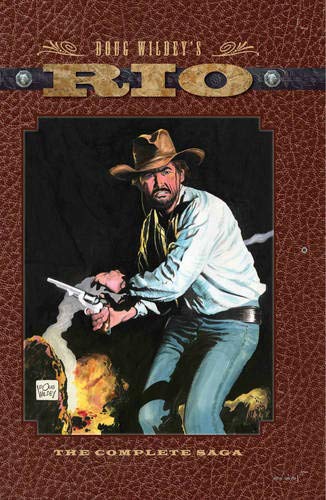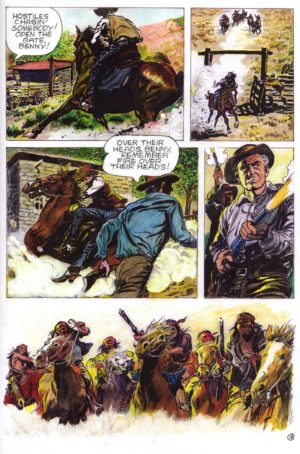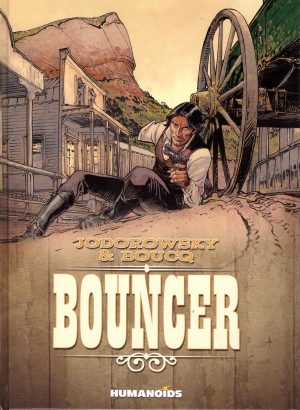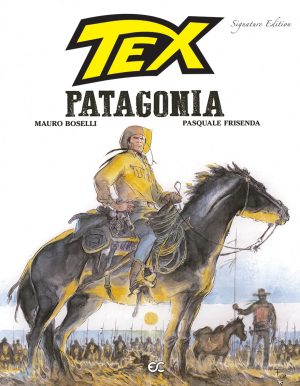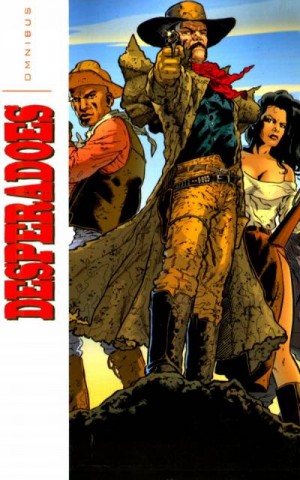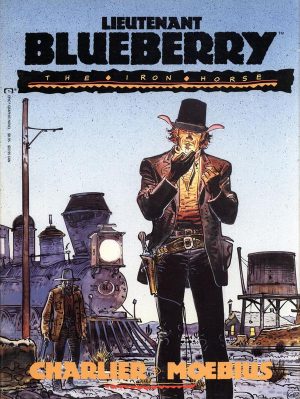Review by Frank Plowright
The Complete Saga is a frustratingly flawed collection. Having all three of Doug Wildey’s superbly drawn Westerns between hard covers is exceptionally welcome. As a bonus, Wildey produced a fourth story without publishing it, and a fifth was unfinished when he died, but with the pages thorough enough that a complete story is told. It’s unlikely there’ll be another Rio collection, and Wildey was a master craftsman whose work stands the test of time, so what’s the problem? Without being promoted as such, although in a far smaller format, it’s a project similar to IDW’s art books, with nearly all the content shot directly from the pages as Doug Wildey drew them.
For connoisseurs and anyone wanting to study technique, it’s a godsend at a bargain price. For anyone whose interest isn’t as technical, and who just wants to read the stories, the presentation isn’t as attractive. Wildey was an industry veteran who knew colours brighten during the transition from finished art to printed page, and prepared the art as muted so that it wouldn’t be too vivid when printed. The results as originally seen in Rio, Rio Rides Again, and Rio at Bay surely came close to matching Wildey’s expectations. In The Complete Saga the colour is dull. The exception is the opening story, differing from the rest as Wildey coloured copies of the letratoned and grey wash art, and that’s reprinted here in black and white. For the remainder he painted the colours directly onto the inked pages, a sure sign of a very confident artist.
Moving onto the stories, fuller reviews of those previously published can be found by following the links, but the short version is that the first two are accomplished Westerns with great art featuring a former outlaw earning his pardon. Rio at Bay also has great art, but the two halves of the story are patched together awkwardly. The first of the newer pieces has Rio accompanying Doc Holliday back to Tombstone. It’s set after the O.K. Corral incident, but enough Clantons remain looking for an opportunity to settle scores with Wyatt and Virgil Earp. It’s a simple story overall, of Rio discovering that even among friends he’s in danger, but keeps twisting away from the expected trail. Wildey’s broadly following the historical path, inserting Rio around known names, but without impacting on their milestones.
Wildey is a great Western artist. He captures the scenery, the people, the situations and the transportation. Most comic artists hate drawing horses, but Wildey revels in them, showing them from all angles and always with life and movement. He keeps his characters looking distinct, with some great creations here, and while Rio remains largely unknowable. People call him friend and trust him, but readers never really know what he’s thinking until he acts. In his introduction Mark Evanier notes that Wildey’s preferred method of working was to pencil, ink, letter and colour each panel before moving to the next. He was either visually aware enough to lay out the full page in his head, or roughed it out separately. The incomplete nature of the final story shows he also adapted his production methods. It’s another gem, with Rio stumbling into the middle of a dangerous situation involving a gang of callous border raiders. It lives up to Wildey’s tentative title of ‘Reprisal’, with glorious scenery toward the end and inventive revenge.
The chances of a full Rio collection seeing the production process through is hardly likely, so the choice is this or the earlier printings and missing out on two good additional stories. The content is stunning, but the production questionable.
